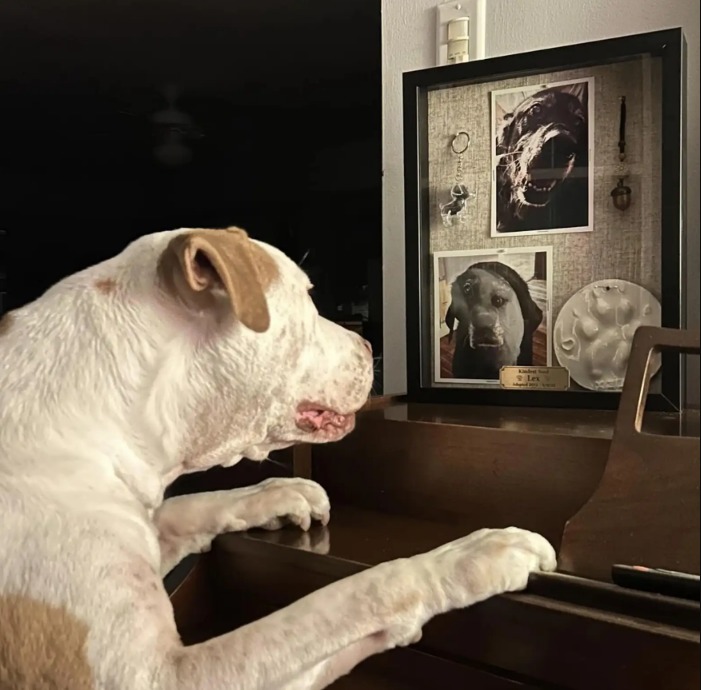
He arrives every. Single. Day.
You’d first see the faint shape of a dog, tail twitching, nose lifted, ears pricked.
Then you’d see the memorial: a small, cherished tribute on the piano—a shadow box, photographs, paw print, fur bits, ashes.
And in that moment, you understand it’s never just a memorial. It’s a connection.
The dog’s name is Vaughn. His late friend was Lex—the senior dog who had been by his family’s side for years.
Vaughn and Lex had what they called a perfect dog friendship: Lex steady, calm; Vaughn younger, playful, always nudging him into games.
Over time, they grew inseparable. Lex was not just a pet. He was a constant, a comfort, the kind of presence you don’t see until it’s gone.
When Lex passed, the home shifted. The quiet echoes lengthened. Vaughn was allowed to see his friend one last time.
He leaned in. Wagged. Stood over him. That farewell tempered some sorrow, but the emptiness remained.
Lex was still everywhere. Everyone missed him. Vaughn probably did most of all.

To help the children remember Lex, Spiro Vganges (their human) created a memorial: a shadow box on the piano, containing Lex’s paw print and fur, his ashes, and several cherished photos.
He placed it in the living room, not realizing how much that would mean—not just to the family, but to Vaughn.
That very night, Vaughn noticed it. He walked in, paused, ears rising, eyes soft. He stepped closer.
Something in his body said: This is him. The memorial was more than a display—it was a connection bridge.
From then on, Vaughn has made it a ritual. He visits Lex’s memorial every single day.
He sniffs it, leans into it, sits near it, sometimes nudges it gently. It’s not theatrics. It’s grief. It’s comfort. It’s love showing up when nothing else can.
What the family saw in Vaughn’s behavior was not obsession—it was mourning made visible. It helped them too.
Watching Vaughn honor Lex removed some of their own sorrow. It reminded them that grieving is not forgetting.
It’s remembering with heart, continuing love in a new form.

Vganges says it really exemplifies the bond they shared.
Lex is gone physically, but his presence remains in that piano room, in those photos, and in the dog who refuses to move on completely. Vaughn essentially protects Lex’s memory.
He visits, daily, because love doesn’t forget.
Some might say a dog doesn’t understand memorials. But Vaughn gives the lie to that. He understands ritual. He understands loss.
He understands companionship. He reminds us that grief isn’t a human monopoly—it’s universal.
Loss is felt in paws and hearts. It’s silent, it’s loud, it’s relational.
So if you ever pass a home and see a dog sitting by a photograph, don’t dismiss it. Don’t think it’s sentimental fluff. It’s pain. It’s faith.
It’s a practice of love.
Because Vaughn is teaching us more than loyalty. He’s teaching us how to carry someone in absence.
How to whisper “you matter” each day.
And how in grief, the dog who stays is sometimes the strongest.



